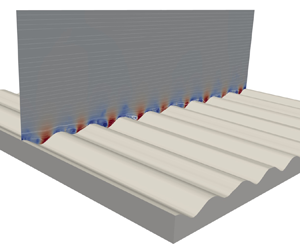No CrossRef data available.
Published online by Cambridge University Press: 31 October 2024

Direct numerical simulations of oscillatory flow over a bed made of ripples have been performed. Two oscillatory flow forcing mechanisms have been compared: (i) a sinusoidal external pressure gradient (pressure-driven flow); and (ii) a sinusoidal velocity boundary conditions on the rippled bed (shear-driven flow). In the second case, the oscillations of the bed are such that when observed from a reference frame fixed with the bed, the free stream follows the same harmonic oscillation as in the pressure-driven case. While the outer layers have the same dynamics in the two cases, close to the bed differences are observed during the cycle, mostly because the large form drag across the ripples cannot be reproduced in the shear-driven case. A comparison against experimental data from an oscillating tray apparatus provides a relatively good agreement for the phase-averaged flow when the same forcing is considered (i.e. a shear-driven flow). The pressure-driven case has a comparable error to the shear-driven numerical results over the crest of the ripples, whereas the discrepancy is larger at the troughs. The discrepancies between the two cases are more limited for time-averaged flow quantities, such as the mean flow pattern and the time-averaged Reynolds stress distribution. This suggests that numerical or experimental shear-driven configurations may capture well the net effects of coastal transport processes (which occur in pressure-driven oscillatory flow), but care should be exercised in interpreting phase-dependent dynamics near the troughs. More work is needed to fully assess the sensitivity to the forcing mechanisms in different flow regimes.